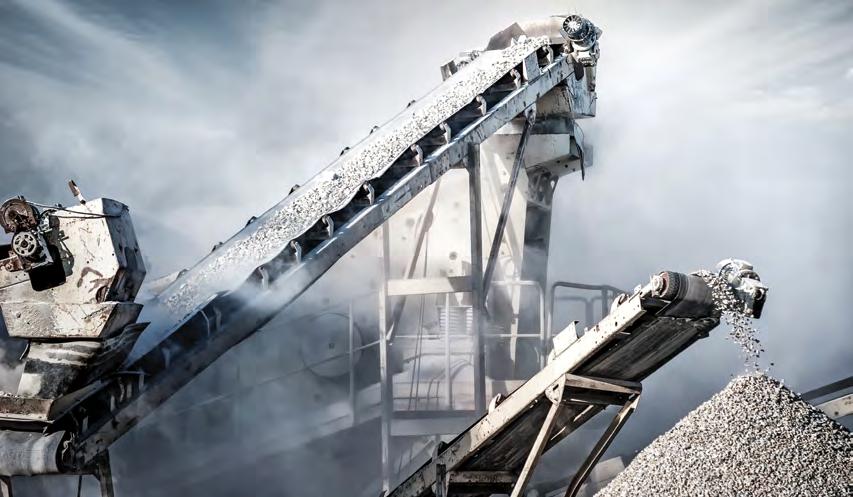
4 minute read
CONCRETE
THE ROAD TO SUSTAINABILITY PASSES THROUGH CONCRETE
The global population boom has resulted in rapid urbanisation in the last century. And urbanisation means a massive uptick in construction, which creates the rampant need for concrete, one of the most widely used materials in the Built Environment. In fact, according to ResearchGate, 10 billion tons of concrete is produced worldwide annually. Furthermore, it is noted that after water, concrete is the most widely used substance on Earth.
All these statistics point towards one conclusion, as the world grows, so does our dependency on concrete. To the extent that production and usage of concrete is responsible for 8 per cent of carbon dioxide emitted in the atmosphere, a huge amount compared to 2.5 per cent of the aviation industry. Concrete’s contribution of carbon dioxide is comparable to the entire agriculture industry, which is responsible for 9 percent of carbon emissions.
The concrete industry needs an overhaul, potentially through the coming together of the industry and governments, focusing on innovation, and enhancing product standards. As a growing industry, it is imperative for it to become sustainable and positively impact the environment.
The biggest challenge for the concrete industry is to serve the two key needs of the society - sustainability and the increasing need for building infrastructures. In this backdrop, Matthew Smith, Associate Head of School, School of Energy, Geoscience, Infrastructure and Society at Heriot-Watt University Dubai, shares his thoughts and insights on improving sustainability in the concrete industry.
LIFE-CYCLE ASSESSMENT OF CONCRETE The analysis of the overall environmental impacts of concrete manufacturing and its application in building projects requires a holistic approach that is known as life-cycle assessment (LCA). Additionally, it is important to assess the life cycle of concrete structures to better understand its environmental impact. Cement, aggregate, and water
are the key constituents of concrete. Each of them comprises of raw materials that require energy consumption and have waste production. Which makes the manufacturing phase most crucial one for the environment. From concrete construction to its lifetime and demolition, the industry must focus on the entire life cycle of how concrete is produced, used, and demolished. Life cycle assessments also support the potential reuse of old concrete. It can be recycled into aggregates after being crushed and processed. For example, concrete pavements can be broken and used as a base course for an asphalt pavement through a process called rubblization. Thereby, life-cycle assessments are key to conscious and sustainable usage of concrete.
USAGE OF SUPPLEMENTARY CEMENTITIOUS MATERIALS (SCM’S) The combination of cement and water which creates a paste is a key component of producing concrete. The paste works as the binder that keeps aggregates in place and provides concrete its industrial properties, making it a dependable and versatile construction material. However, the substance is not sustainable. Although used traditionally for years, the construction industry has now seen the introduction of supplementary cementitious materials. These are natural materials or industrial byproducts that exhibit cementitious properties when combined with either only water or water and other compounds. SCMs generated because of industrial manufacturing processes include fly ash, slag cement, and silica fume. Natural SCMs, created by applying heat and purifying processes to certain minerals, include calcined shale, calcined clay and metakaolin. Substituting components of the cement in concrete with SCMs, or making blended cement, is the swiftest short-term solution to decrease carbon emissions from the cement and concrete industry.
AN ALTERNATIVE MATERIAL IN GREEN CONCRETE Green alternatives are the future of a sustainable world. While different socalled green concretes have been on the scene for many years, it is only now that the world of construction is taking a more serious look at the material. Green concrete can be produced using waste material as one of its components and production processes that are not harmful to the environment. The criteria for green concrete are that the materials used for making it should be sourced from sustainable or safe materials rather than non-sustainable components - a better solution to regular concrete in many ways. For example, it uses fly ash, a byproduct of coal combustion, as one of its main components. Other materials that form part of green concrete are silica fume, a byproduct of manufacturing silicon and ferrosilicon, recycled glass and ground granulated blast furnace slag, waste material in the production of steel and iron. There are many benefits to using green concrete. Due to its lower rate of shrinkage than regular concrete, green concrete lasts longer. Structures built using this alternative material also have a better chance of surviving fires, as it can endure temperatures of up to 2400 degrees Fahrenheit.
Underpinning the above is the need to create a more sustainable future. With investment in the development and deployment of the most efficient methods to combat the environmental damages of concrete, we will be able to witness a massive change in carbon emissions globally. While the world goes through massive urbanisation, and the population moves towards cities, governments, academia, and the industry must come together to make one of the most environmentally damaging industries less harmful. Academia develops the research needs, the industry contributes to innovation, and governments drive policy change. In fact, in 2019, students at Heriot-Watt University Dubai created a research solution for sustainable concrete production, which used recycled coarse aggregate and ceramic waste, both of which are widely available in the UAE, to develop green concrete.







